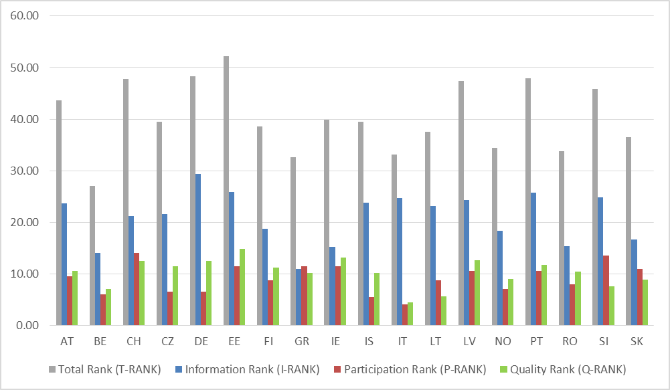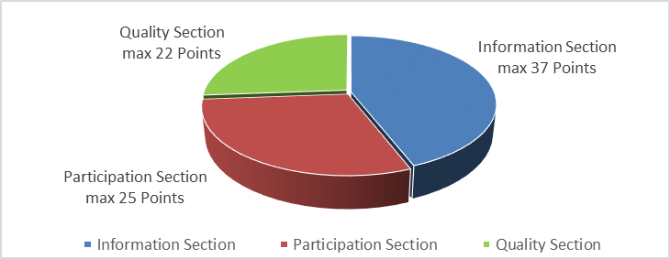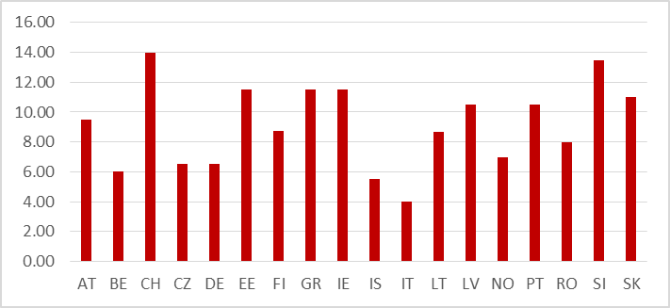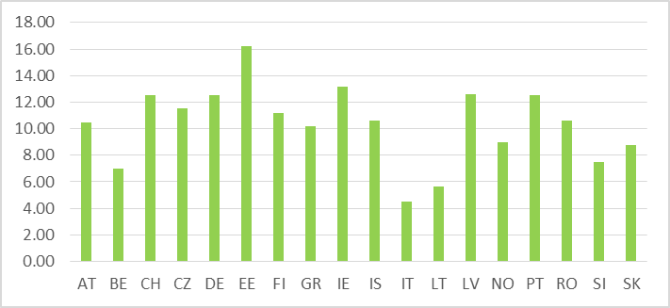1.
Introduction ^
«The best weapon of dictatorship is secrecy, but the best weapon of democracy should be the weapon of openness.»
(Niels Bohr)
2.
Methodology ^
The detailed data regarding the achieved points and rank per country are as follows:
3.
Availability of Information ^
3.1.
Legislation ^
Legislation on central as well as constitutional law level is available online in all contributing countries, while ordinances25 are in approximately two thirds and sub-constitutional law26 is in approximately 56% of the examined countries available. Legislation on a sub-regional level27, regional level28 as well as internal ordinances of public authorities, which only bind civil servants29 are available online in less than 30% of the countries. In Ireland acts and statutory instruments are available online mainly in their «as-enacted» form. In Switzerland, cantons set rules for the publication of their legislation30.
3.2.
Jurisdiction ^
4.
Participation in Law Drafting Process ^
4.1.
Preparation ^
4.2.
Availability of the Results of Public Consultations ^
5.
Quality Aspects ^
5.1.
Impact Assessment for Drafts ^
6.
Conclusions ^
7.
Acknowledgements ^
Valerie Kainz, Scientific Assistant, Intelligent Law & Internet Applications
Sebastian Reimer, CEO, Intelligent Law & Internet Applications, Lerchenfelderstraße 124-126/1/19, 1080 Wien, AT, office@crystal-law.at; http://www.crystal-law.at
- 1 These countries are: Austria, Belgium, Czech Republic, Estonia, Finland, Germany, Greece, Ireland, Iceland, Italia, Latvia, Lithuania, Norway, Portugal, Romania, Slovakia, Slovenia and Switzerland.
- 2 To guarantee a minimum of relevancy, only replies with at least 50 percent of the questions answered were taken into account.
- 3 http://www.crystal-law.at/wp-content/uploads/2015/02/e_legislation_survey.pdf (5 February 2015).
- 4 This section consists of questions 7, 9, 11 to 13, 15 to 17, 19, 21 and 27 with a maximum of 37 points.
- 5 This section consists of questions 5, 22, 23 and 24 with a maximum of 25 points.
- 6 This section consists of questions 6, 20 and 25 with a maximum of 22 points.
- 7 http://www.ris.bka.gv.at (9 February 2015).
- 8 http://www.staatsblad.be (9 February 2015).
- 9 http://portal.gov.cz/app/zakony/?path=/portal/obcan (10 January 2015).
- 10 Legislation from 1995 on, is available at: https://www.riigiteataja.ee/en (10 January 2015).
- 11 Legislation from 1926 on, is available at: http://www.finlex.fi/fi/laki (10 January 2015).
- 12 http://www.juris.de (10 January 2015).
- 13 http://www.parliament.gr/en/Nomothetiko-Ergo/Psifisthenta-Nomoschedia (10. February 2015).
- 14 http://www.althingi.is (10 January 2015); http://www.reglugerd.is (10 January 2015); http://www.stjornartidindi.is (10 January 2015).
- 15 http://www.irishstatutebook.ie/home.html (10 January 2015), since 1781.
- 16 http://www.normattiva.it (10 January 2015); http://www.camera.it (10 January 2015); http://www.governo.it (10 January 2015).
- 17 https://www.vestnesis.lv (10 January 2015); consolidated versions of legislation from 1993 on, are available at: http://likumi.lv (10 January 2015).
- 18 Legislation as of 2013 is available at: http://www.eteismas.lt (10 February 2015).
- 19 https://lovdata.no/register/lover (11 January 2015).
- 20 Legislation from 1910 on, is available at: http://www.dre.pt (10 January 2015).
- 21 Legislation from 1995 on, is available at: http://www.lege-online.ro/legislatie-romaneasca (10 January 2015).
- 22 https://lt.justice.gov.sk/Public/AllMaterialsList.aspx (10 January 2015).
- 23 Legislation from 1991 on, is available at: http://www.pisrs.si/Pis.web/pravniRedRS (10 January 2015).
- 24 http://www.admin.ch/bundesrecht/00566/index.html?lang=de (10 January 2015); Legislation from 1998 on, is available at: http://www.admin.ch/bundesrecht/00567/index.html?lang=de (10 January 2015).
- 25 Austria, Czech Republic, Estonia, Finland, Germany, Iceland, Ireland, Lithuania, Portugal, Romania, Slovenia and Switzerland (12/18).
- 26 Austria, Belgium, Czech Republic, Estonia, Finland, Germany, Iceland, Lithuania, Slovenia and Switzerland (10/18).
- 27 Austria, Belgium, Czech Republic, Estonia, Finland, Germany, Iceland, Latvia, Romania and Slovenia (10/18).
- 28 Austria, Belgium, Estonia, Finland, Germany, Italy, Portugal and Switzerland (8/18).
- 29 Austria, Finland, Germany, Lithuania and Switzerland (5/18).
- 30 http://www.lexfind.ch (10 January 2015).
- 31 Austria, Belgium, Czech Republic, Estonia, Finland, Germany, Greece, Iceland, Ireland, Italy, Lithuania, Portugal, Romania, Slovenia and Switzerland (15/18).
- 32 Austria, Belgium, Czech Republic, Estonia, Finland, Iceland, Italy, Lithuania, Portugal, Romania, Slovenia and Switzerland (12/18).
- 33 Austria, Belgium, Czech Republic, Estonia, Finland, Iceland, Slovenia and Switzerland (8/18).
- 34 Austria, Czech Republic, Estonia, Lithuania, Romania, Slovenia and Switzerland (7/18).
- 35 http://alex.onb.ac.at/zeitlichegliederung.htm (11 February 2015).
- 36 http://www.staatsblad.be (11 February 2015).
- 37 Supreme Court Jurisdiction as from 2003 is available at: http://www.nsoud.cz/JudikaturaNS_new/ns_web.nsf/WebSpreadSearch (11 January 2015); jurisdiction of the Supreme Administrative Court (from 2003 on) is available at: http://www.nssoud.cz/main0col.aspx?cls=JudikaturaBasicSearch&pageSource=0 (11 January 2015); jurisdiction of the Constitutional Court (since 1993) is available at: http://nalus.usoud.cz/Search/Search.aspx (11 January 2015).
- 38 https://www.riigiteataja.ee/en (5 February 2015).
- 39 http://www.finlex.fi/fi/oikeus (10 January 2015).
- 40 http://www.juris.de (10 January 2015).
- 41 Paid services only.
- 42 Jurisdiction from 1999 on, is available at: http://www.haestirettur.is (10 January 2015); http://www.domstolar.is (10 January 2015); http://www.fonsjuris.is (10 January 2015).
- 43 Jurisdiction as from 2001 (Supreme Court) and 2004 (High Court) is available at: http://www.courts.ie/Judgments.nsf/FrmJudgmentsByCourtAll?OpenForm&l=en (10 January 2015).
- 44 http://www.cortecostituzionale.it (10 January 2015); jurisdiction from 1956 on, is available at: http://www.giustizia-amministrativa.it (10 January 2015).
- 45 http://www.tiesas.lv/tiesu-nolemumi (10 January 2015); http://at.gov.lv/lv/judikatura/judikaturas-nolemumu-arhivs/ (10 January 2015); jurisdiction from 2007 on, is available at: http://www.satv.tiesa.gov.lv/?lang=1&mid=19&smode=1 (10 January 2015).
- 46 http://liteko.teismai.lt/viesasprendimupaieska/detalipaieska.aspx?detali=2 (10 January 2015).
- 47 Jurisdiction from 1836 on, is available at: https://lovdata.no/register/dommer (11 January 2015).
- 48 http://www.dgsi.pt (10 January 2015); http://www.tribunalconstitucional.pt (10 January 2015).
- 49 Jurisdiction from 2008 on, is available at: http://www.jurisprudenta.org/Search.aspx (10 January 2015).
- 50 http://www.pisrs.si/Pis.web/sodnaPraksaRS (10 January 2015).
- 51 http://www.eidgenoessischegerichte.ch (10 January 2015).
- 52 Belgium, Estonia, Finland, Italy, Norway, Portugal, Romania, Slovakia and Switzerland (9/18).
- 53 Austria, Czech Republic, Greece, Latvia, Norway, Romania, Slovakia, Slovenia and Switzerland (9/18).
- 54 Austria, Romania and Slovenia (3/18).
- 55 Latvia (1/18).
- 56 Norway, Portugal and Slovenia (3/18).
- 57 Romania (1/18).
- 58 Lithuania (1/18).
- 59 Austria, Czech Republic, Estonia, Finland, Germany, Greece, Iceland, Ireland, Latvia, Lithuania, Norway, Portugal and Romania (13/18).
- 60 Austria, Czech Republic, Estonia, Italy, Latvia, Lithuania, Norway, Slovenia and Switzerland (9/18).
- 61 Czech Republic, Estonia, Norway, Slovenia and Switzerland (5/18).
- 62 Austria, Belgium, Czech Republic, Estonia, Finland, Germany, Greece, Iceland, Ireland, Italy, Latvia, Norway, Portugal, Romania, Slovakia and Switzerland (16/18).
- 63 Austria, Czech Republic, Estonia, Finland, Germany, Greece, Iceland, Ireland, Latvia, Norway, Lithuania, Romania, Slovenia and Switzerland (14/18).
- 64 Austria, Czech Republic, Estonia, Finland, Germany, Greece, Ireland, Latvia, Norway, Slovenia, Romania and Switzerland (12/18).
- 65 Czech Republic, Estonia, Finland, Germany, Greece, Iceland, Ireland, Latvia, Norway, Slovenia, Portugal, Romania and Switzerland (13/18).
- 66 Austria, Belgium, Czech Republic, Estonia, Finland, Germany, Greece, Ireland, Latvia, Norway, Portugal, Romania and Switzerland (13/18).
- 67 Austria, Belgium, Czech Republic, Estonia, Finland, Germany, Greece, Ireland, Latvia, Portugal, Romania and Switzerland (12/18).
- 68 Austria, Czech Republic, Estonia, Finland, Germany, Greece, Lithuania, Iceland, Ireland, Latvia, Portugal, Romania and Switzerland (13/18).
- 69 Austria, Czech Republic, Estonia, Finland, Germany, Greece, Ireland, Latvia, Norway, Romania and Switzerland (11/18).
- 70 Austria, Belgium, Czech Republic, Finland, Germany, Ireland, Norway, Portugal, Romania and Switzerland (10/18).
- 71 Belgium, Czech Republic, Finland, Germany, Norway, Romania and Slovenia (7/18).
- 72 So-called «Analisi tecnico-normative», http://www.camera.it/temiap/temi16/DIR_PCM_10_09_2008.pdf (10 January 2015); «Analisi di Impatto della Regolazione», http://www.camera.it/temiap/temi16/DPCM_170_2008.pdf (10 January 2015).
- 73 These studies also aim at regional impacts, impacts on health of the population and consequences with regard to the objective of obtaining simpler regulations and less complex public administration. In practice, the extent of the impact assessments vary considerably.
- 74 Like environmental impacts, impacts on consumer, privacy impacts and other financial impacts (besides financial impacts on public authorities).
- 75 Austria, Belgium, Czech Republic, Estonia, Finland, Iceland, Latvia, Lithuania, Norway, Romania and Switzerland (11/18).
- 76 Germany and Italy (2/18).
- 77 Ireland (1/18).
- 78 Lithuania and Portugal (2/18).
- 79 https://www.ris.bka.gv.at/Begut (10 January 2015).
- 80 https://apps.odok.cz/ (10 January 2015); http://www.psp.cz/en/sqw/sntisk.sqw?F=N (10 January 2015).
- 81 http://eelnoud.valitsus.ee (10 January 2015).
- 82 http://dip.bundestag.de (10 January 2015).
- 83 http://www.innanrikisraduneyti.is/sam/drogtilumsagnar (10 January 2015).
- 84 http://www.camera.it (10 January 2015); http://www.senato.it (10 January 2015).
- 85 http://tap.mk.gov.lv/mk/tap/search (10 February 2015); http://titania.saeima.lv/LIVS12/saeimalivs12.nsf/webAll?OpenView (10 February 2015).
- 86 http://www.lrs.lt (10 February 2015); http://www3.lrs.lt/dokpaieska/forma_l.htm (10 February 2015).
- 87 http://debates.parlamento.pt (10 January 2015).
- 88 http://www.cdep.ro/pls/proiecte/upl_pck.lista?std=DZ (10 January 2015); http://www.senat.ro/LegiProiect.aspx (10 January 2015).
- 89 http://e-uprava.gov.si/e-uprava/edemokracija.euprava (10 January 2015).












